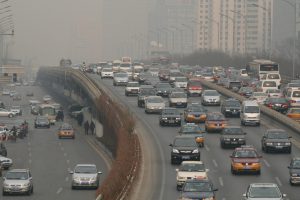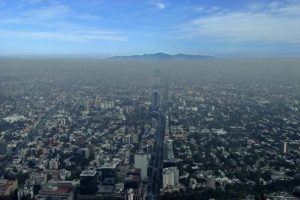In his address to China’s National People’s Congress on March 5, Premier Li Keqiang called for “heavy blows” to be struck against air and water pollution that have exacted a heavy toll on large swaths of the world’s most populous country.
Li cited targets to improve environmental standards across the board, but focused in particular on measures to tackle urban smog that would deliver “good air quality” day readings for 80% of the year.
The targets are part of the forthcoming 13th Five-Year Plan (FYP), a policy blueprint that will shape China’s economic development over the next five years up to 2021.
The premier’s speech was delivered on the opening day of the session and set the tone for discussions that will continue until March 16.
The full list of proposals will not be published until the close of the twin legislative sessions. However, Li’s speech has already indicated that the government will limit factory emissions of tiny harmful particulate matter (PM2.5) – a major cause of air pollution – down by 25%.
This is the first time in the China’s history that a specific PM2.5 target has been included in a FYP.
The other main targets revealed in the government’s work report include: to reduce of emissions from coal burning industries and vehicles; to bolster cleaner and more efficient use of coal; to promote the use of electricity and natural gas in place of coal; support for wind, solar and bio power sectors; an increase in the proportion of clean energy; encourage the use of waste straw as a resource; a reduction in-field burning; and implementation of control measures to deal with air pollution.
Professor Hu Angang of Tsinghua University’s School of Public Policy and Management said that the 13th Five-Year Plan will provide a guide for how ‘green development’ will be implemented, and how it will align with economic growth.
“Achieving green growth means reducing energy and resource intensity and decoupling the emissions of key pollutants from economic growth and urbanisation,” he said.
Inefficiency snuffed out
Li spoke of recent efforts to restructure China’s economy. Since the implementation of the Five-Year Plan, the service industry has grown considerably, energy intensity per unit of GDP has fallen by 18.2%; and emissions of key pollutants have dropped by over 12%.
By 2020, he said, the intensity of water use per unit of GDP will fall by 23%, energy intensity by a further 15%, and carbon intensity by 18%.
The premier also said that China is addressing over-production in its energy intensive industries, such as construction and manufacturing, through corporate restructuring (the details of which remain undisclosed).
In the last three years, the closure of inefficient firms has removed 90 million tonnes of steel production, 230 million tonnes of concrete production, over 76 million tonnes of plate glass, and 1 million tonnes of aluminium from China’s bloated manufacturing sector.
In China, local governments have traditionally had three functions: to manage public services; social welfare; and market regulations. A fourth important function is being added to that list, that of environmental protection.
Local governments
Hu Angang told chinadialogue that the 13th FYP is proving the local governments with the tools and targets to switch orientation.
“In the design of the 13th FYP, we’ve seen a shift from talking about industrial counties, industrial cities and industrial provinces, to talking about green development. China has already entered the era of green development… [which will] reduce [industrial] capacity by shutting down energy-intensive and polluting firms.”
Manish Bapna, executive vice president of the World Resources Institute, hopes to see the 13th FYP include ambitious targets for action on the use of clean energy, the tackling of air pollution, forest-creation and dealing with soil and water pollution – and more importantly, a real shift in how the Chinese economy grows.
“I hope to see the Chinese government do more to change the traditional method of development, which is reliant on increasing supply. Often people think increasing the water supply means building more dams, increasing the energy supply means building more power stations. But actually we should look at how to reduce demand and decouple resource consumption from economic growth.”
Something in the air
Smog appeared to be the focus of discussion both inside and outside of Beijing’s assembly halls. On the first day of the Lianghui Assembly, the city issued an amber pollution alert, meaning that schools and kindergartens were advised to keep children inside.
Song Zuying, a member of the CPPCC and famous singer, joked that while members from Beijing might be used to the foul air, those from other parts of the country would have to acclimatise.
While official figures showed air quality in China had improved in 2015, many people did not feel this was the case, One journalist pointed out at a CPPCC press conference. Wang Guoqing, a CPPCC spokesperson, responded that ending smog will require a sustained effort.
“Pollution does not form overnight, nor can our efforts to end it see immediate effect,” said Wang.
According to media reports, air pollution was one of the main topics at local-level Lianghui meetings, with local government work reports citing specific smog targets for the first time.
Green belts
In Beijing, the city government intends to reduce PM2.5 levels by 5% in 2016. In northeastern Jilin, officials will launch a clean air action plan.
At the national policy level, CPPCC member Xu Jiankang proposed a smog tax and a congestion charge in order to reduce vehicle emissions. People’s Representative Li Sheng said that residential and other buildings should be required to include internal green belts to help clean the air and reduce smog.
Meanwhile, Yi Jianqiang, a Chinese Academy of Sciences expert added that the precise causes of smog are still unclear and need to be further investigated.
The view that smog is caused by vehicle exhaust fumes is more popular with the public than with scientists, he said.








